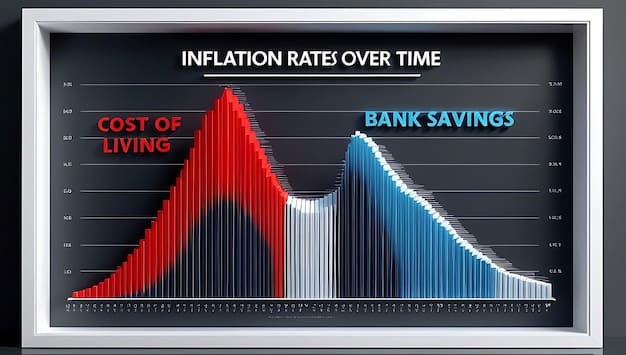The Basel III Endgame rules introduce updated capital requirements for US banks, significantly altering how they manage risk and potentially impacting their lending capacity in 2025 through increased capital buffers.
The financial landscape in the United States is on the cusp of significant change as the Basel III Endgame rules loom on the horizon. What are the updated capital requirements for US banks under the Basel III Endgame rules, and how will they impact lending capacity in 2025? This is a question that’s front of mind for bankers, economists, and anyone keeping an eye on the health of the US economy.
Understanding the Basel III Endgame
The Basel III Endgame represents a comprehensive set of reforms designed to enhance the regulation, supervision, and risk management of the banking sector. It’s a response to the lessons learned from the 2008 financial crisis, aiming to create a more resilient and stable financial system. These rules aren’t new, but rather a recalibration and strengthening of existing regulations.
Key Components of Basel III Endgame
The Basel III Endgame touches on various aspects of bank operations, all with the intent of making banks safer and more reliable.
- Increased Capital Requirements: Banks will be required to hold more capital as a percentage of their assets. This acts as a buffer against potential losses.
- Risk-Weighted Assets: Stricter calculations of risk-weighted assets mean banks need to more accurately assess the riskiness of their investments.
- Stress Testing: Regular stress tests simulate adverse economic conditions to ensure banks can withstand financial shocks.
These components work together to ensure that banks are better prepared to handle unexpected financial challenges, reducing the likelihood of future crises.
In essence, Basel III Endgame is about ensuring banks have enough capital to absorb losses, manage risks effectively, and withstand economic downturns.
Decoding the Updated Capital Requirements
At the heart of the Basel III Endgame are the updated capital requirements, which significantly influence how banks operate and how much they can lend. These requirements are not just about holding more capital, but also about how that capital is calculated and what risks it covers.

Tier 1 Capital and Common Equity
The cornerstone of the updated capital requirements revolves around Tier 1 capital, particularly common equity. This is the highest quality capital a bank can hold, comprising primarily of shareholder equity and retained earnings. The Basel III Endgame mandates a higher proportion of Tier 1 capital relative to a bank’s risk-weighted assets.
This focus on Tier 1 capital makes banks more robust because it’s the capital that can absorb losses most effectively without triggering a default.
Impact on Risk-Weighted Assets
The new rules also tighten the calculation of risk-weighted assets (RWAs). RWAs are a measure of a bank’s exposures, weighted according to risk sensitivity. Under the Basel III Endgame, banks must apply more granular and conservative methodologies to determine RWAs, leading to potentially higher capital needs.
This means that banks will need to reassess the riskiness of their assets more stringently, possibly leading to adjustments in their investment strategies.
The updated capital requirements are significantly changing the way banks manage their balance sheets and assess risk.
How Basel III Endgame Impacts Lending Capacity
One of the most pressing concerns surrounding the Basel III Endgame is its potential impact on the lending capacity of US banks. Higher capital requirements can directly affect the amount of money banks have available to lend to businesses and individuals.
- Reduced Lending: As banks need to hold more capital in reserve, they may have less capital available for lending, potentially reducing the overall credit supply.
- Increased Lending Rates: Banks might increase lending rates to compensate for the higher capital costs, making borrowing more expensive for consumers and businesses.
- Shift in Lending Focus: Banks may become more selective in their lending practices, favoring lower-risk loans and industries, which could affect the availability of credit for certain sectors.
These potential impacts are significant for economic growth, as lending is a critical driver of business investment and consumer spending.

Ultimately, the changes in lending capacity could have ripple effects throughout the economy, impacting businesses of all sizes and individual borrowers.
Navigating the Challenges of Basel III Endgame
Implementing the Basel III Endgame is not without its challenges. Banks must adapt their operations, technology, and risk management practices to comply with the new rules. This transition period can be complex and costly.
Operational Adjustments
Banks need to invest in new systems and processes to accurately calculate their capital requirements and risk-weighted assets. This requires significant financial and technological resources.
Strategic Realignment
Banks may need to reassess their business strategies, adjust their asset portfolios, and refine their lending practices to optimize their capital efficiency. This could involve selling off certain assets or focusing on more capital-efficient activities.
Compliance and Reporting
Increased regulatory scrutiny and reporting requirements demand heightened attention to compliance. Banks must ensure they meet all regulatory expectations and can demonstrate compliance to supervisors.
The challenges associated with Basel III Endgame implementation underscore the need for careful planning and strategic decision-making by banks.
The Broader Economic Perspective
While the Basel III Endgame is primarily a regulatory initiative, it has implications that extend far beyond the banking sector, influencing the broader economy and financial stability. The macroeconomic impact could be substantial.
Impact on Economic Growth
Reduced lending capacity and higher borrowing costs could dampen economic growth by limiting investment and consumption. This is a key concern for policymakers.
Financial Stability
On the other hand, a more resilient banking system could enhance financial stability, reducing the risk of future crises and protecting the economy from severe downturns.
Global Competitiveness
The implementation of Basel III Endgame in the US could affect the competitiveness of US banks relative to their global peers, particularly if other countries implement the rules differently.
The benefits of a more stable and resilient financial system need to be carefully weighed against potential constraints on economic growth and competitiveness.
Preparing for 2025: Strategies for US Banks
As 2025 approaches, US banks need to proactively prepare for the full implementation of the Basel III Endgame. Strategic planning and decisive action are essential to navigate the challenges and capitalize on the opportunities ahead.
Capital Planning
Banks should conduct thorough capital planning exercises to assess their capital needs and develop strategies to meet the new requirements. This may involve raising additional capital, retaining earnings, or optimizing their asset portfolios.
Risk Management Enhancement
Strengthening risk management practices is critical. Banks need to refine their risk models, improve data quality, and enhance their risk governance structures.
Technological Investment
Investing in technology is essential to streamline compliance, improve efficiency, and enhance decision-making. This includes upgrading systems for capital calculation, risk assessment, and reporting.
By taking these steps, US banks can position themselves for success in the new regulatory environment and continue to play a vital role in supporting economic growth.
| Key Point | Brief Description |
|---|---|
| 🏦 Higher Capital | Banks must hold more capital as a buffer against losses. |
| 📉 Lending Impact | Potential reduction in lending capacity and higher borrowing costs. |
| 💡 Strategic Shifts | Banks may realign strategies to optimize capital efficiency. |
| 🌍 Economic Effects | Broader economic impact on growth and financial stability. |
FAQ Section
▼
The primary objective is to strengthen the regulation, supervision, and risk management of banks to prevent future financial crises by ensuring they hold sufficient capital.
▼
Small businesses might face higher borrowing costs or reduced access to credit as banks adjust their lending practices to meet new capital requirements.
▼
Tier 1 capital is the core capital of a bank, including common equity and retained earnings, which can absorb losses without triggering a default.
▼
Risk-weighted assets are a measure of a bank’s exposures, adjusted based on the perceived risk of each asset. Basel III Endgame tightens how these are calculated.
▼
The full implementation is scheduled for 2025, requiring banks to prepare their operations and strategies to align with the new regulatory landscape.
Conclusion
The Basel III Endgame represents a significant shift in the regulatory landscape for US banks. While it aims to create a more stable and resilient financial system, it also presents challenges for banks in terms of capital requirements, lending capacity, and strategic adjustments. Successfully navigating these challenges will be crucial for ensuring the continued health and stability of the US economy.

